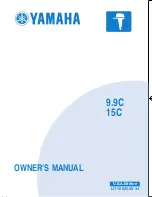
16
- Fuel and Oil
FUEL SYSTEMS
IMPORTANT:
Fuel distribution hoses in the boat
must deliver fuel at the rate of flow needed by the
engine. Minimum inside diameter of fuel hoses
must be 5/16 in. (8 mm).
Fuel systems with built-in tanks, particularly those
that include antisiphon valves and filter/primer
units, may have restrictions that will not allow the
engine fuel pump to deliver sufficient fuel under all
conditions. This can result in a loss of performance
and possible
engine damage
. If a performance
problem exists, see your Dealer.
To avoid difficulty when restarting, never run the
engine with the fuel hose disconnected or run the
engine out of fuel.
BREAK-IN (10 HOURS)
IMPORTANT:
Follow this procedure to protect your
new outboard during its initial hours of operation.
Careful break-in allows internal engine components
to “seat” properly, resulting in maximum engine per-
formance.
Failure to carefully follow the break-in procedures
can result in engine damage.
During break-in, you must use extra oil. The fuel/oil
ratio for the first 10 hours of operation must be 25:1
(4% oil). The fuel/oil ratio during normal operation,
after break-in, must be 50:1 (2% oil).
Perform the
10-Hour
break-in procedure with the
boat and engine in the water, using an appropriate
propeller.
DO NOT perform break-in using a flushing device.
DO NOT start-up or run the engine out of the water.
DO NOT leave a running engine unattended.
IMPORTANT: Before the first start-up of your
new engine:
• Read
Engine Starting
,
Engine Stopping
, and
Shifting and Speed Control
.
• Check the gearcase lube level. Refer to
Lubrica-
tion
.
• Perform prelaunch checks of all equipment.
Launch the boat and start the engine according
to the procedures in Engine Starting.
• Verify water pump operation often. Look for a
steady stream of water from the water pump indi-
cator. If the stream of water stops, shut off the en-
gine to prevent damage. Find and correct the
cause, or see your Dealer before you continue.
• Verify shift function by shifting into gear and ob-
serving that the boat moves and that the move-
ment is in the same direction as the shifter. Refer
to
Shifting and Speed Control
.
• Change the RPM often. Avoid holding a throttle
setting longer than 15 minutes.
1. First 10 Minutes of Operation —
Operate the
engine in gear at fast idle
only
.
2. Next 50 Minutes —
Operate engine in gear at
various speeds no faster than 3500 RPM.
DO NOT
hold a constant throttle setting. Change
engine speed every 15 minutes.
With easy planing boats, use full throttle to quickly
accelerate boat onto plane. Immediately reduce
throttle to one-half as soon as boat is on plane. BE
SURE boat remains on plane at this throttle setting.
3. Second Hour —
Use full throttle to accelerate
boat onto plane, then reduce throttle setting to
three-quarters. BE SURE boat remains on plane at
this throttle setting.
At intervals, apply full throttle for periods of one to
two minutes, returning to three-quarters throttle for
a cooling period.
Change engine speed every 15 minutes.
4. Next Eight Hours —
Avoid continuous full
throttle operation for extended periods.
Change engine speed every 15 minutes.
DO NOT
exceed recommended maximum engine
RPM. Refer to
Engine Specifications
.
WARNING
If your motor is equipped with a quick-dis-
connect fuel hose, disconnect the fuel hose
from the motor and from the fuel tank when
the motor is not being used for a period of
time. Disconnecting the hose will avert fuel
leaks in the hose or at the engine.
Содержание 2 Stroke 40 HORSEPOWER
Страница 11: ...General Information 9 NOTES ...
Страница 48: ...46 Maintenance Bombardier Motor Corporation of America ...
Страница 49: ...Maintenance 47 Bombardier Recreational Products ...
Страница 52: ... 215599 ...
















































